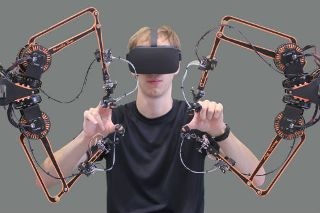Oct 22 2019
Building and using a robotic device without the need for expensive, exclusive kit or skills would be extraordinary. The scientists from the University of Bristol have made this vision a reality by developing a lightweight, economical, and simple solution for ordinary users.
 Mantis, designed by Bristol’s experts in human-computer interaction, is the first system of its kind that enables light, affordable and accessible haptic force feedback. (Image credit: University of Bristol)
Mantis, designed by Bristol’s experts in human-computer interaction, is the first system of its kind that enables light, affordable and accessible haptic force feedback. (Image credit: University of Bristol)
While several robotic arm devices are already in existence, most are costly, heavy, and beyond the reach of people who lack the proficiency to work them.
Mantis, built by specialists in human-computer interaction from Bristol’s distinguished team of engineers, is the first system of its kind that allows light, low-cost, and accessible haptic force feedback.
Human beings possess five senses, but electronic devices communicate with the those using mainly just two: hearing and sight. Haptic feedback (frequently abridged to just haptics) alters this by mimicking the sense of touch. An individual can not only touch a computer or other device but also have the computer touch them back. A force feedback is a specific kind that can deliver force.
Ideally, the Mantis could be fabricated and used by anyone with a secondary school certificate and more. Furthermore, the scientist says the Mantis can be manufactured for 20 times less cost than a market equivalent because it uses components, including brushless motors that cost considerably less than high-fidelity counterparts that are frequently confined to research labs.
“Humans already have a great sense of touch. Mantis expands on this innate ability by enabling people to touch and feel 3D objects, adding more depth to the VR experience,” says lead researcher Dr Anne Roudaut, from Bristol’s Department of Computer Science.
“Imagine a user playing a game in Virtual Reality with Mantis attached to their fingers. They could then touch and feel virtual objects, thus immersing themselves both visually and physically in an alternative dimension.”
Dr Roudaut and her PhD student Gareth Barnaby will showcase the Mantis at the User Interface Software and Technology (UIST) conference in New Orleans between 19th and 23rd October. The UIST conference is a premier platform for innovations in human-computer interfaces that sees people from tangible and ubiquitous computing, graphical and web user interfaces, and virtual and augmented reality.
Project Mantis is also backed by a new spin-out venture, Senmag Robotics, which scientists hope will allow them to commercialize their design, beginning with the production and testing of the first kits ready for launch by year-end.
“We will be giving out the plans to allow anyone to build a Mantis,” adds Gareth Barnaby. “Because we are keen to make force feedback devices more widespread and not confined to research labs, we are also looking to produce some easy to build kits as well as pre-built versions that we will make available on the website.”
This research was backed by the Engineering and Physical Sciences Research Council (EPSRC) and the Leverhulme Trust.
Mantis: New Haptic Arm Places Robotics Within Easy Reach
Imagine being able to build and use a robotic device without the need for expensive, specialist kit or skills. That is the vision that researchers from the University of Bristol have turned into reality, creating a lightweight, affordable and simple solution for everyday users. (Credit: University of Bristol)